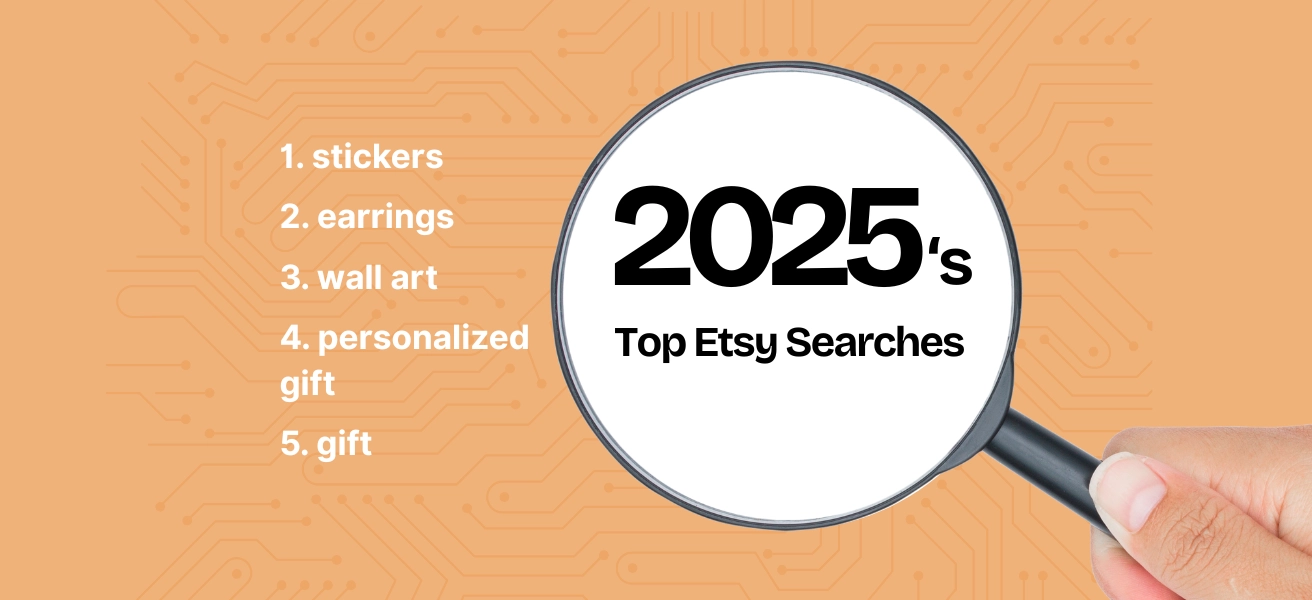This post is also available in: Français
If you’re new to Etsy or struggling to get your products in front of potential buyers, you’re not alone. With so many shops and listings, standing out can be tough. That’s where SEO comes in.
SEO (Search Engine Optimization) is how you make sure your products appear in search results when buyers type in keywords. On Etsy, SEO works a bit differently than it does on Google. In this post, we’ll break down the basics of Etsy SEO and give you some tips you can start using in your own shop right away.
What Is Etsy SEO and How Does It Work?
Etsy SEO helps connect shoppers to your listings by using keywords (the words buyers type in the search bar) and other factors to rank products. Etsy’s search algorithm considers a few things when deciding which listings to show in a search, including:
- Keywords: Etsy looks for keywords in your listing titles, tags, descriptions, and attributes.
- Listing Quality Score: Etsy tracks how well your listings perform. Things like clicks, favorites, and sales matter. The better your listings perform, the higher they rank.
- Shop Quality: The quality of your shop is important in building trust with your buyers. Having a shop icon which represents your brand as well as other graphic elements is important in building shop quality.
- Customer Service: Message response rate, case rate, and average review rating all have weight in how your products rank in Etsy search.
- Recency: Newer listings may get a temporary boost in search to test how they perform.
- Relevancy: Etsy favors listings that match what shoppers are actively searching for.
Now that we’ve got a basic idea of what Etsy SEO is, let’s dive into how you can improve your shop’s visibility with some actionable tips. For an extensive list of factors that affect your search visibility check out the Etsy Seller Handbook’s article on how Etsy search works.
Etsy SEO Basics You Can Implement Today
- Research Keywords That Buyers Are Actually Searching For
The first step toward optimizing your shop is understanding what keywords your potential customers are using. You’ll want to use keywords that describe your product in the same order that shoppers would type them into the search bar. For example, if you’re selling handmade wooden trays, try using specific terms like “handmade wooden tray” or “rustic serving tray” rather than just “tray.”
Where to start:
- Use Etsy’s search bar to see what autocomplete suggestions come up when you type in your product. This gives you an idea of what people are actually looking for.
- Use tools like eRank to analyze keyword trends, see search volumes, and get ideas for keywords you may not have thought of.
- Optimize Your Titles and Tags
Once you’ve got a list of good keywords, the next step is making sure they show up in your listing titles and tags.
- Titles: Your title should include the most important keywords, ideally near the beginning. For example, instead of just saying “Tray”, use something like “Handmade Wooden Tray – Rustic Serving Tray for Home Décor”. Avoid stuffing your title with keywords; Etsy recommends keeping titles concise and easy to read.
- Tags: Tags are equally important. You get 13 tags on Etsy. We recommend using them all! Make sure each tag is relevant to your product and reflects how buyers would search. For instance, your tags could include phrases like “handmade home décor”, “wooden tray gift”, or “rustic kitchen accessory”. Avoid single word tags when possible.
- Superstar Keyword: These are short phrases that describes your listing. eRank uses these to provide more relevant information for each listing.

- Write an Effective Product Description
Although Etsy doesn’t directly index product descriptions for SEO, a well-written description can increase your conversion rates. This signals to Etsy that your product is relevant to shoppers’ searches, which can help improve your overall search ranking.
Your description should:
- Describe your product clearly and in detail.
- Mention your primary keywords in a natural way (without keyword stuffing).
- Answer common customer questions like dimensions, materials, and usage.
- Use All Relevant Attributes
When creating your listing, Etsy allows you to choose attributes like color, size, material, and occasion. These are used by Etsy to filter search results, so make sure you fill in all of the attributes that apply to your product.
For example, if you’re selling jewelry, use attributes like “gold”, “handmade”, or “wedding”. These attributes act like extra keywords that help your product appear in filtered searches.
- Pay Attention to Your Photos
Photos aren’t just about making your product look good; they can also affect your search ranking. Etsy favors listings with high-quality, clear images. Make sure your photos showcase your product from multiple angles and in use, if possible. Keep in mind that your first photo acts as your first impression to buyers. Make sure this photo clearly represents your product and entices customers to click through to the product.
Bonus tip: Etsy allows you to add a video to your listing. Videos give buyers a better sense of your product, which can boost engagement and help your ranking.
- Don’t Fall for the “Active Listings” Myth
There’s a common misconception among Etsy sellers that making changes to your listings or regularly updating them will give you a temporary boost in search results. While it’s true that newly created listings receive a short-term boost—so Etsy can test them in search results—simply tweaking existing listings doesn’t trigger the same effect.
That said, regularly updating your listings is still a good idea. It’s not for an SEO boost, but for other important reasons: refreshing photos, improving descriptions, or adding new keywords can make your product more appealing to buyers and lead to higher conversion rates. Higher sales and engagement signal to Etsy that your listing is relevant, which can help improve its ranking over time.
So, while updating listings won’t magically move you up in search, keeping your listings fresh and optimized for your audience will still benefit your shop in the long run.
- Use Etsy Search Analytics
Etsy provides sellers with tools to track how well their listings are performing in search. In your shop dashboard, under Shop Manager, you’ll find Search Analytics. This feature shows you which keywords shoppers are using to find your products and how your listings perform for those searches.
Use this data to fine-tune your listings. If certain keywords are driving a lot of traffic, try using them more in other listings. If you notice a listing isn’t performing well, consider adjusting its tags, title, or description.
Final Thoughts on Etsy SEO
Etsy SEO might seem a bit overwhelming at first, but once you start implementing these tips, it becomes second nature. By using the right keywords, optimizing your titles and tags, and paying attention to performance, you can help more people discover your products.
If you’re looking for more in-depth insights, tools like eRank can help you track trends and competition, making it easier to fine-tune your SEO strategy. Don’t forget to use Etsy’s own analytics to continually monitor and improve your shop’s performance.
With time, patience and a bit of experimentation, you can strengthen your shop’s SEO and get your items in front of more shoppers on Etsy!







